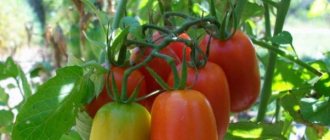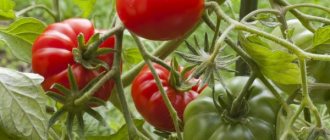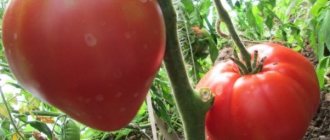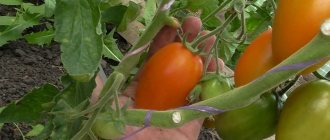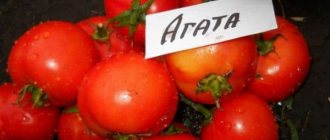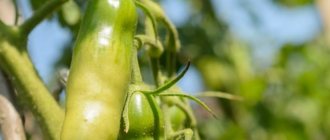Some hybrid varieties of tomatoes have long been time-tested and are still popular among vegetable growers. These include the Budenovka tomato. Description of the variety and reviews indicate its excellent characteristics.
Every gardener who has at least once planted a Budenovka tomato on his plot was captivated by its excellent agrotechnical and nutritional qualities.
Description of the variety
In their taste and appearance, Budenovka tomatoes resemble the well-known variety Bull's Heart. Their bushes are not standard, they have a powerful root system with a diameter of about 0.5 m and are characterized by the absence of growth points - under favorable conditions and the absence of restrictions, the stems of the Budenovka tomato can grow up to 3-4 m. Therefore, their tops should be pinched.
The distinctive qualities of the hybrid variety Budenovka are:
- thin tall stem up to 1-1.5 m, which requires garter;
- a small number of tomato-type leaves and a characteristic dark green color;
- early fruit ripening - approximately 110 days;
- high resistance to common tomato pathologies;
- depending on the climatic conditions of the region, the Budenovka tomato can be grown in open ground or in greenhouses;
- the variety is unpretentious to growing conditions and produces high yields even in rainy seasons;
- The yield from 1 tomato bush, on average, can be approximately 5-7 kg.
The nuances of growing tomato Budenovka
What you need to pay attention to is the choice of seeds. The same varieties from different manufacturers often have different characteristics and appearance. It is best to purchase seeds from a trusted company or buy different ones for comparison.
It is best to purchase seeds from a trusted company or buy different ones for comparison.
Photo gallery: assortment of seeds from different companies
Budenovka tomatoes are grown in seedlings. Pre-sowing preparation of seeds and soil is no different from other varieties.
Seeds are sown in containers with fertile soil approximately 60 days before the intended planting in the ground. To speed up germination, the container is covered with polyethylene, which is removed immediately after the seedlings appear. In the phase of two true leaves, plants are planted in separate cups with a volume of 250–300 ml. Many gardeners use peat pots for these purposes or make paper cups themselves. Seedlings grown in this way can then be easily and simply transplanted into the ground - the root system will not be damaged, and the plants will not get sick after transplantation.
Making paper cups will not take much time and will save money
After two or three true leaves appear, tomato seedlings begin to be fed. For fertilizing, you can use complex mineral fertilizer and organic fertilizer for vegetables or a solution of vermicompost. On sale you can find many different ready-made fertilizers specifically for tomato seedlings - the microelements in them are selected taking into account the needs of these particular plants. The main thing when feeding is the alternation of organic and mineral additives. The instructions for the drugs describe in detail the preparation of the solution and the proportions that must not be violated. If in any doubt, it is better to take a smaller amount of the substance, since overfeeding can lead to disastrous results.
Planting tomatoes in the ground
Planting Budenovka tomatoes and further care are no different from other varieties. The beds for tomatoes are prepared in the fall. When digging, add 1 cup of ash, 35 g of superphosphate and 30 g of potassium salt per square meter.
Recent posts 6 decorative maples that can be planted in any part of the gardenFlowers that reproduce well by self-sowing5 plants that can be used to plant the dampest areas of your garden
When planting in a garden bed, the plants are placed in a checkerboard pattern. The distance between tomatoes is 40 cm in a greenhouse and 50 cm in open ground, between rows is 40 cm. After planting, the tomatoes are immediately tied to pegs or a trellis, and the ground around the plants is mulched.
Further care for tomatoes takes place as usual - watering, fertilizing, weeding, pinching.
If the soil in the garden bed is mulched, then you need to water it rarely, but abundantly, and you won’t have to weed or loosen the soil at all.
Video: shaping tomatoes
Grown tomatoes of the Budenovka variety are formed into one, less often two, stems. In the first case, all emerging stepsons are removed, in the second, one, the most powerful one, is left in the lower part of the trunk. Very quickly it will catch up with the main shoot and will develop in parallel. This technique will help to obtain large fruits of good quality. When tying tomatoes, each stem is tied separately.
Tomatoes of the Budenovka variety are formed into one or two stems
The Budenovka tomato was one of the first to appear in our greenhouse. Our greenhouse is small, 3 x 6, so you can’t really spread out, but I try to grow at least a few bushes of different varieties. I buy seeds from a proven, reliable manufacturer. In May - June, the sun in our region usually burns mercilessly and the temperature in the greenhouse rises above +30 °C. Many tomato varieties simply drop their ovaries in such conditions. Budenovka, surprisingly, copes with extreme heat and sets fruit with enviable consistency. The harvest is spread out and the last tomatoes are collected at the end of September. The fruits, especially the first ones, are large, shiny, without cracks and very tasty. The bushes were never affected by pests and did not suffer from anything.
Fruit characteristics
The fruits of the Budenovka variety acquire an appetizing pink-red color after ripening. They begin to ripen in open ground by the end of July, and they need to be picked already in the ripeness phase, since by this time the tomatoes inside are fully ripe. Their shape is heart-shaped, round, with an elongated nose, reminiscent of the famous headdress of the Red Army soldiers, which is where the name of the Budenovka variety comes from.
The fruits are large, their diameter reaches 15 cm, and their weight is on average 300 g, although sometimes it can be more. Despite their large size, tomatoes do not crack, retain their shape well during transportation and have good shelf life:
The Budenovka tomato, as evidenced by the characteristics and description of the variety, is universal in use - it is indispensable for fresh summer salads, for winter preparations, and for fresh freezing. Its excellent taste is noted - sweet juicy pulp with a slight sourness. And the rich mineral composition makes the Budenovka variety an essential component in dietary nutrition. With regular consumption of tomatoes:
- cholesterol levels in the blood decrease;
- blood pressure is normalized;
- the functioning of the digestive system improves.
Getting seeds from your garden
To grow the Budenovka tomato variety, it is recommended to collect the seeds yourself. To obtain high-quality seeds you need:
- without removing from the bush, bring the largest and healthiest tomato fruit to full ripening;
- remove the pulp with seeds and fill it with water in a glass container;
- after a week, when the mixture sours in a warm place, the tomato seeds will float to the surface;
- they need to be washed, placed on a clean napkin and dried in a dry, ventilated place;
- For storing seeds, a glass container that can be hermetically sealed is best suited - it should be filled halfway.
Important! You need to attach a label to the jar, which will indicate the collection time and the type of seeds.
Features of cultivation and storage
It is recommended to grow Budenovka tomatoes through seedlings. To do this, seeds are sown:
- For a greenhouse - in mid-March;
- For open ground - late March - early April.
15 days before transplanting to a permanent location, the seedlings are hardened off. You can plant seedlings when the soil has warmed up to 15-17 degrees. To do this, prepare holes in a checkerboard pattern, the distance between which should be about 50 cm. Fertilizer is added to them and the prepared seedlings are placed. It is immediately recommended to install supports and tie plant stems to them, as they are very weak and thin.
When the bushes stretch up to 50 cm in height, a bush of 1 stem is formed, and pinching is carried out. The procedure is repeated every 10 days.
More information about growing tomatoes is described in the article: Technology of growing tomatoes. Secrets of planting and care.
You might be interested in: How to properly plant tomatoes in a greenhouse: bush formation diagram, care features, photos and videos
The southern regions are suitable for growing without shelter; in all other regions it is recommended to use polycarbonate greenhouses.
Budenovka is considered a tall tomato, the height of which can reach 1.5 m, the ripening period of the fruit is average. The first harvest can be harvested on average 110 days after sowing the seeds in the ground. They have a fleshy consistency, a sweetish taste, a pink-red color and a heart-shaped shape. The weight of one fruit can be 200–400 g; about 6 kg of tomatoes are harvested from a bush per season.
There is also Grandma's Budenovka - this variety is considered ancient and late-ripening. The fruits are round and orange-red in color. Tomatoes are considered ideal for canning.
First of all, special attention must be paid to the choice of seeds. It is recommended to buy seed material in specialized seed stores, as this will reduce the risk of purchasing a counterfeit or low-quality product
After the fermentation process is over, the seeds are washed, placed on a cloth and dried in a well-ventilated area. Seeds should be stored in a glass container that closes tightly and should be no more than half full. To find out where each seed is, it is recommended to stick a label on the container. Material collected in this way can be used even after 10 - 12 years.
Seeds are sown from late February to mid-March. The boxes are kept under film until shoots emerge. Growing seedlings consists of the following stages:
- hardening at 15 degrees;
- irrigation through a spray bottle;
- picking with 2-3 true leaves;
- feeding with a mineral nutrient mixture.
Early maturing / Tall
User rating: 4/5
Early maturing / Tall
User rating: 5/5
Late ripening / Tall
Sowing seeds for seedlings
Sowing of Budenovka tomato seeds for seedlings is carried out in March-April, depending on local climatic conditions. But tomato seedlings can be transplanted into open ground only after 1.5-2 months, after the night frosts have gone. The seedlings must first be hardened off gradually.
Important! In the southern regions, Budenovka tomatoes can be immediately planted in open beds by mid-April, when the average air temperature is about 17 degrees.
Before sowing, it is necessary to cull the seeds, first by visual means. Then pour them into a 1.5 percent solution of table salt. Poor quality seeds float, while healthy ones settle to the bottom. They are washed and disinfected in a weak solution of potassium permanganate. It is also recommended to soak tomato seeds in a growth stimulator. After this, you can plant it in preheated and disinfected soil, deepening it by about 2 cm.
To germinate seeds faster, some gardeners resort to a little trick - placing tomato seeds in a damp cloth for several days. There is another way to speed up the development of seeds - cover them after sowing and watering with glass or plastic wrap for several days. As soon as the seedlings hatch, you need to remove the film.
Planting and watering
When the first cluster of color appears on the seedlings, the tomatoes can be transplanted into separate holes. The Budenovka tomato variety loves fertile soils, so it is better to plant it in beds where zucchini, parsley, and carrots previously grew. You need to add a small handful of humus to each hole. The preferred planting pattern is checkerboard. Tomato seedlings can be planted at a distance of 30-35 cm from each other, and a gap of more than 0.5 m can be left between the rows.
The optimal watering regime is 2 times a week until flowering and ovary formation. Later, watering Budenovka tomatoes is reduced to once a week. After watering, you need to loosen the soil around the bushes and tear off excess lower leaves.
How to grow tomatoes
So, the time has come to plant plants in open ground or a greenhouse. Follow the recommendations below to get a good harvest
Landing
When planting seedlings in a permanent place, it is important to do this on time so that the plants do not die or get sick.
Seedlings are planted in open ground only when there are no frosts at night, the time depends on the region and climate, for example, in the southern regions of the country, seedlings are planted already in April.
The soil for tomatoes is prepared in spring. The planting area is dug up along with humus or compost. Gardeners advise planting the Budenovka variety where zucchini, parsley, and carrots previously grew, since the soil after these crops is fertile. Such plants are called green manure; they provide crop rotation for tomatoes and allow you not to change the place for planting tomatoes every year.
Note : Green manures are plants that are planted in areas of the garden that will later be planted with another crop. Green manure produces dense greenery, which is dug into the soil. Greens saturate the soil in the selected area with nitrogen and humus, reduce the growth of weeds, and prevent the spread of diseases.
Green manure greens are used as mulch. Mulch is plant organic matter: stems, leaves of plants, which are laid on the soil to enrich it with humus. The mulch cover provides the soil layer with the necessary supply of beneficial microorganisms. In the process of decomposition of such a layer, the mineralization of nutrients accelerates and the efficiency of their absorption by plants increases.
In the selected area or in the greenhouse, the soil is dug up, loosened, holes are made, in each of which compost and ash are placed. The holes are dug at a distance of 30 cm from each other. There is a gap of 50 cm between the rows.
Pour water into each hole. Once the water has been absorbed, place a seedling in each hole. The bush should be lowered to the first leaves, sprinkle soil on top. It is recommended to put straw on the soil, which will retain moisture around the bush.
Stick a peg near each bush and tie the plant to it as it grows.
Care
The Budenovka variety is unpretentious in care. Tomatoes should be watered 2 times a week, at the root. Feed with fertilizers - once every two weeks. After transplantation, fertilizers containing nitrogen, phosphorus, and potassium are used not for seedlings, but for tomatoes. It is better to use ready-made fertilizer mixtures.
It is recommended to form Budenovka bushes into one stem, so the fruits will be larger. In early August, the plant is pinched so that the bush stops growing upward and forms more fruit-bearing branches. As the bushes grow, remove the lower leaves to improve photosynthesis. For the Budenovka variety, pinching is required, that is, removing shoots from the leaf axils. Gardeners recommend trimming the lateral roots so that the root system develops better.
Gardeners also recommend lightly tapping the tomato stem during flowering, thereby aiding pollination. It is better to remove flowers that did not have time to form an ovary at the end of the flowering season.
Features of cultivation and possible difficulties
As mentioned above, the Budenovka variety is unpretentious in care; the only difficulties that the gardener faces are the preservation of the stems. The stems of the variety are long and thin and easily break under the weight of the fruit. To avoid this, it is recommended to carefully tie the bush to the supports and promptly remove unnecessary parts.
Diseases and pests
The Budenovsky variety is resistant to pests and has good immunity to major tomato diseases. However, for prevention, it is recommended to spray the bushes with a solution of garlic juice several times a season.
Note : To combat insects such as mole crickets, wireworms, and caterpillars, it is recommended to use special chemicals: “Grom”, “Match”, “Promark” and others.
Methods for increasing yield
There are various ways in which you can increase the yield of Budenovka tomato. Reviews from gardeners indicate such techniques as:
- timely removal of stepsons from the leaf axils, which take a significant share of nutrients from the plant;
- pinching the main root when planting seedlings to stimulate the formation of lateral roots that can provide the bush with a sufficient amount of nutrients;
- pruning lateral roots contributes to the formation of a stronger root system and improved nutrition of the upper part of the tomato;
- pinching the top of the central stem stimulates the growth of lateral branches and an increase in the number of fruiting shoots;
- timely removal of excess leaves that shade the bushes due to too small a distance between them helps to increase the degree of illumination and the efficiency of the photosynthesis process;
- tapping the tomato stem during flowering helps complete pollination and ovary formation;
- By the end of the season, removing flowers from the stem that have not yet formed an ovary reduces the consumption of food on them.
Care technology
Characteristics and reviews indicate that the main disadvantage of the Budenovka tomato is that the stems are too thin. They will break easily under the weight of the fruit. Therefore, gartering of bushes is necessary. Otherwise, the technology for caring for Budenovka tomatoes is quite simple:
- the first fertilizing is carried out during the flowering period of plants;
- the next feeding should be carried out during the formation of the ovaries in order to provide the tomato with the nutrition necessary for fruiting;
- It is recommended to fertilize tomatoes of the Budenovka variety with infusions of herbs with wood ash, humus, potassium and phosphorus salts;
- They should be watered at the root, avoiding water getting on the foliage;
- by mulching tomatoes with compost, you can maintain a sufficient level of moisture under the bushes; to allow oxygen to reach the roots, periodically loosen the soil under the tomatoes and clear it of weeds;
- Approximately once a week, carry out preventive spraying of Budenovka tomato with garlic infusions or other disinfectants.
There are other varieties of tomatoes that are distinguished by their ease of care, excellent taste and early ripening, for example, the Sevruga tomato variety. The difference between the Budenovka tomato and Sevruga is that the latter is not a hybrid variety, and its fruits can reach 1 kg.
Advantages and disadvantages of the variety
Budenovka receives only positive reviews, even from fastidious vegetable growers. The tomato is not fussy and easy to care for. Gives a generous harvest under any, including bad weather conditions.
Due to the beautiful shape of the fruit, this variety of tomatoes sells well in markets; they can be grown for sale
pros
- suitable for cultivation in all regions of the Russian Federation;
- the bushes are medium-sized (on average 1 m), do not need high supports;
- good yield;
- fairly early ripening;
- resistance to major tomato diseases;
- fruits of original shape, medium and large size;
- tomatoes can be used universally, that is, eaten fresh, prepared from them into vegetable salads, canned foods, juice, which turns out tasty and thick, and made homemade tomato paste.
The Budenovka variety has no significant disadvantages. But for some gardeners who grow tomatoes for canning in jars, the large fruit may be a disadvantage.
Reviews
In fact, the Budenovka variety has no negative reviews. All summer residents speak of it as a universal variety that combines a lot of positive characteristics.
Ivanova Ekaterina, 55 years old, Astrakhan
I planted the Budenovka tomato for the first time last year. I really liked the fruits - large and juicy. I want to plant a larger area with them next year.
Sakharov Konstantin, 67 years old, Volgograd
I have been growing the Budenovka tomato variety for several years now and am pleased with its unpretentiousness. You just need to tie it up in time - the stems are very fragile, and the taste is wonderful.
Kharitonov Zakhar, 72 years old, Voronezh
I planted two beds of Budenovka tomatoes in the greenhouse for testing. The harvest exceeded all expectations - almost 6 kg per bush. The fruits are juicy, fleshy, and have excellent taste. I really liked the variety.
Karavaeva Valentina, 63 years old, Krasnodar region
We have been growing the Budenovka tomato variety for many years and are very pleased with its properties. I like the taste of the fruit with a pronounced tomato aroma. We make all winter preparations from this variety. We place smaller tomatoes in jars whole, and process large fruits into tomato juice or sauces.

